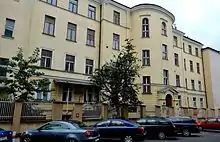Warsaw Ghetto Museum
The Warsaw Ghetto Museum is a history museum in Warsaw currently under construction. It will open in 2023, on the 80th anniversary commemoration of the Warsaw Ghetto Uprising.[1] The museum will be located in the buildings of the former Bersohn and Bauman Children's Hospital in Warsaw at 51 Śliska Street and 60 Sienna Street. On October 19, 2018 Museum director, Polish-Jewish historian Albert Stankowski received a key to the property from a government official and signed a long-term lease during a ceremony at the future museum site.[2] Its chief historian is Daniel Blatman.[3]

History
The decision on the establishment of the Warsaw Ghetto Museum was adopted in November 2017 by Piotr Gliński,[4] deputy prime minister of Council of Ministers and the Minister of Culture and National Heritage. The museum organisation was registered on 28 February 2018. A press conference held on 7 March 2018 at the Chancery of the Council of Ministers was devoted to the establishment of the new institution, with the Prime Minister Mateusz Morawiecki and the Minister of Culture and National Heritage Piotr Gliński in attendance.
The Warsaw Ghetto Museum’s mission includes “the dissemination of knowledge about the history of the Warsaw ghetto being a crucial part of the history of The Holocaust as planned and executed by the German Third Reich”[5] The Museum’s Director is Albert Stankowski.
In July 2018, the Museum made the first outdoor exhibition dedicated to the history of the Bersohn and Bauman Children's Hospital available to the capital city’s citizens. The exhibition was composed of 20 boards placed on the building’s fence at 51 Śliska/60 Sienna Street.[6] In April 2019, the Warsaw Ghetto Museum opened its second exhibition at the Monument to the Ghetto Heroes, “Standing up straight, unbent... Nathan Rapaport and the Monument to the Ghetto Heroes”, dedicated to Nathan Rapaport, the monument’s author. The Warsaw Ghetto Museum was a co-organiser of the 76th anniversary of the outbreak of the Warsaw Ghetto Uprising. The programme included, among others concerts, screening of the film “Border Street” (Polish: Ulica Graniczna), a theatre performance, and the main celebrations at the Monument on 19 April.
The next outdoor exhibition “Postcards from our neighbourhood... The history of Sienna and Śliska Streets” was opened on 14 May 2019 on the fence of the former Bersohn and Bauman Children's Hospital at 60 Sienna Street. The exhibition presents over the course of three centuries the changing part of the capital, constituting the outskirts of the city still in the 17th century and today its very centre that combines the three past centuries, while being Warsaw’s a modern centre.[7]
The museum has started its educational activity: an offer has been prepared for both primary school pupils and secondary school students. Free museum lessons, lectures for universities of the third age, and educational strolls have been conducted.[8] At the end of March 2019, a three-day training for teachers, educators, and guides entitled: “Around the Warsaw Ghetto and other ghettos in occupied Poland” was organised.[9]
In October 2018, the local government of the Mazovia Province leased to the Museum the complex of the Bersohn and Bauman Children’s Hospital for a period of 30 years. In 2018, the buildings of the former hospital were entered by the Monument Conservator of the Mazovia Province on the list of historical monuments.[10] The main exhibition is to be located in the hospital's four-story main building, and the education department is to move to the one-story building of the former ophthalmology department.
Goals
The statutory activities of the Museum include:
- establishing the research base for the development and dissemination of knowledge on the Warsaw Ghetto history through collection, preservation and scholarly editing of material and non-material testimonies;
- creation of exhibition space and a research institution for the purpose of inspiring reflection on the Warsaw ghetto history;
- integration of the activities undertaken with the aim of protecting and conservation of cultural heritage of the Jews imprisoned in the Warsaw ghetto;
- undertaking initiatives as regards renovation and regeneration of the historical monuments of the Warsaw ghetto;
- conducting cultural, research, educational and promotional activities related to the history of the Warsaw ghetto;
- initiation of social initiatives and lending support to them, and to non-governmental organisations contributing to the protection and commemoration of the history of the Warsaw ghetto;
- perpetuating the memory of the founders of the historic Bersohn and Bauman Children’s Hospital and of Warsaw’s nineteenth century and early twentieth century Jewish community.
References
- "Poland: Warsaw Ghetto museum will show the 'mutual love' between Poles, Jews".
- https://m.washingtontimes.com/news/2018/oct/19/poland-moves-closer-to-creating-museum-on-warsaw-g/
- http://1943.pl/en/professor-daniel-blatman-in-the-warsaw-getto-museum/
- "Press conference of Prime Minister Mateusz Morawiecki and Deputy Prime Minister, Minister of Culture and National Heritage Piotr Gliński". www.premier.gov.pl.
- "Warsaw Ghetto museum to show ties with Jews - Israel National News". Israel National News.
- https://www.facebook.com/ipngovpl/posts/10160796162820245
- http://1943.pl/en/the-history-of-sienna-and-sliska-streets-wgms-third-outdoor-exhibition/
- http://1943.pl/en/an-educational-stroll-with-students/
- http://1943.pl/en/teach-disseminate-commemorate-raise/
- https://www.mwkz.pl/archiwum-aktualnosci-lista/1106-budynki-dawnego-szpitala-dziecicego-im-bersohnow-i-baumanow-w-rejestrze-zabytkow